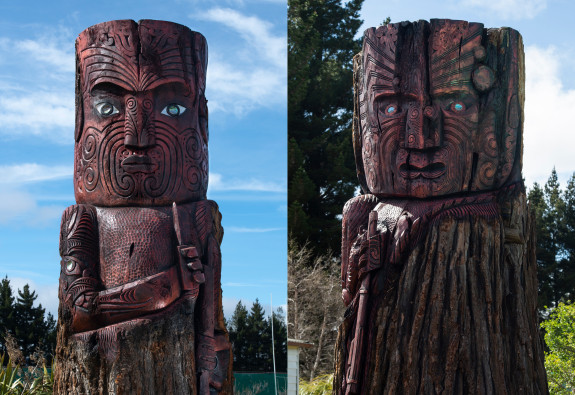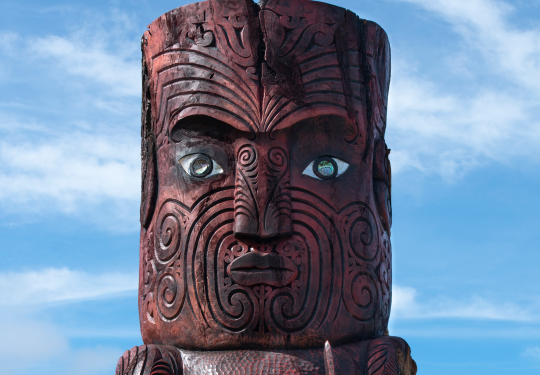Rongomarae Roa o Ngā Hau e Whā New Zealand Army National Marae reopens
Two unique pouwhenua were unveiled on the grounds of Rongomarae Roa o Ngā Hau e Whā, New Zealand’s National Army Marae at a ceremony in November.
15 November, 2021
Dignitaries and soldiers gathered on the marae as dawn broke and watched as the stately pouwhenua were blessed.
The pouwhenua, carved by cousins Ted and Kurt Barham of Makakahi Enterprises were carved out of trees on the marae grounds that were dying and had become dangerous.
They were unveiled by the Chief of Army Major General John Boswell, along with the oldest and youngest soldiers of Ngāti Tūmatauenga – Mr Robert (Bom) Gillies who is the last surviving member of 28 Māori Battalion, and Recruit Gareth Komene who was the youngest recruit undergoing Basic Training.
The carvings were unveiled by the Chief of Army Major General John Boswell, Mr Robert (Bom) Gillies, and Recruit Gareth Komene.
Rongomarae Roa o Ngā Hau e Whā is the spiritual home of Ngāti Tūmatauenga, and all new recruits are welcomed on to the marae, and into Ngāti Tūmatauenga during their basic or initial officer training. MAJGEN Boswell told those gathered the unveiling was a celebration. “Firstly we celebrate the reopening of this very special Marae, the New Zealand Army National Marae, which has undergone some significant renovation to bring it up to code, and to refresh it, so that it can continue to play a critical role in the life of Ngāti Tūmatauenga.”
“These carvings, He Hoia and He Toa are magnificent. Today we are also celebrating the signing of a Memorandum of Understanding between the New Zealand Army and Awanuiārangi, whose assistance will help the New Zealand Army, not only live, but progress our culture of Ngāti Tūmatauenga.”

He Hōia – A Soldier (right), and He Toa - A Warrior (left) stand at the grounds of Rongomarae Roa o Ngā Hau e Whā.
Rongomaraeroa O Ngā Hau E Whā was established 25 years ago at the instigation of the then-Chief of Defence, the late LieutenantGeneral Tony Birks. On the outskirts of the Waiouru Military Camp, the marae is the spiritual home of Ngāti Tūmatauenga, the name granted to the Army by Māoridom in 1994.
TRADOC Commander Colonel Trevor Walker said the Memorandum of Understanding between Wānanga te Whare o Awanuiārangi and the New Zealand Army was another firm step towards realising the vision of a succession of Chiefs of Army, from General Birks to General Boswell whose support of Te Kura o Tūmatauenga would create an Army School, whose mission will be creating the cradle of education and support to strengthen the culture of Ngāti Tūmatauenga.
“The mission of Te Kura o Tūmatauenga will primarily be building depth and strength in the understanding of Te Ao Māori within the New Zealand Army. It seeks to take the concept of Ngāti Tūmatauenga beyond what it is now and make its acceptance, practice and understanding both deep and wide across our Army. It will do this in partnership with Wānanga te Whare o Awanuiārangi and with the continued support of our local Iwi.”
Two unique pouwhenua were unveiled on the grounds of New Zealand’s National Army Marae at a ceremony in November.
COL Walker said the New Zealand Army, as part of the Treaty Negotiations on the Central Plateau, was obligated to be a partner with tangata whenua. “Our kura will look to provide the education and training to those soldiers who will undertake the role of iwi liaison within our camps and bases. Not only here in Waiouru, but also in Papakura, Linton, Trentham and Burnham.
“We owe it to our soldiers to be culturally safe when representing Ngāti Tūmatauenga. To do this we need to provide the training, and more importantly the kaiako who can take the Ngāti Tū kaupapa to the units and soldiers across the motu, so that learning and embracing Te Ao Māori is not only something done when soldiers come to Waiouru. Te Kura o Tūmatauenga will be the genesis of the journey for our soldiers who also wish to become kaiako and kaitiaki of Ngāti Tūmatauenga. With our partner, the formal learning will occur here so that the kaupapa of Ngāti Tū is standardised and becomes entwined into our everyday training.”
COL Walker said as the Army has evolved it understands better than ever that one of its underlying strengths is its heritage. “A part of this heritage, which has always been there, but not acknowledged as well as it could have been, is the unifying aspect of Ngāti Tūmatauenga. With the importance of the Warrior Culture in Te Ao Māori, it is a natural fit for the Army to incorporate this culture, to build on the European and British military ethic and enhance it in our own New Zealand way into something powerful and unifying.”
Dignitaries and soldiers gathered on the marae as dawn broke and watched as the stately pouwhenua were blessed.
The meanings behind the carvings
He Toa - A Warrior, is a tribute to all Soldiers and Officers that have served in our Army Post Vietnam War including South-East Asia, All peacekeeping and monitoring deployments. This carving also welcomes all future Soldiers and Officers into the Ranks and Files of the New Zealand Army.
He Hōia - A Soldier, is a tribute to all Soldiers and Officers that have served in our Army during the New Zealand Wars, Boer War, World War I, World War II, the Korean War, the Malayan Emergency, Borneo Confrontation and the Vietnam War, including J Force.
We are grateful to former 2/1 RNZIR soldier Kurt Barnham and his cousin Edwin Barnham from Makakahi Enterprises for the care and excellent craftsmanship that has gone into creating these two taonga.
We would also like to formally thank and acknowledge local iwi for their ongoing support. Representatives were at the unveiling in November, and we welcome every opportunity to continue strengthening our friendship and whanaungatanga.
Learn more about Te ao Māori in our Defence Force
